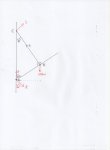jonnburton
Junior Member
- Joined
- Dec 16, 2012
- Messages
- 155
Hi,
I was wondering if anyone could help me with this problem which I am not sure how to approach.
The diagram (copied below), shows a man of mass 70kg at rest while abseiling down a vertical cliff. Assume that the rope is attached to the man at his centre of mass. You should model the man as a uniform rod and assume that he is not holding the rope.
a) Draw a diagram to show the forces acting on the man

b)Find the minimum value of the coefficient of friction between his feet and the cliff if he remains at rest.
I do find these problems quite hard to visualise.
As far as I can see, the reaction force S and the weight (686N) are trying to rotate around point A clockwise. The tension in the rope is trying to rotate around point A anticlockwise.
If, for the sake of this we can take the distance from the rope to the feet as 1 metre:
The perpendicular distance of the weight force from A is cos 30, so the moment of this force around A is 686cos30
As the system is in equilibrium, T opposes this rotation, so its moment is also 686cos30 (in the opposite direction).
But I need to get the value for the frictional force and R... I think the problem is that I'm failing to visualise what needs to be done here and I'd be very grateful if anyone could tell me how to approach the problem.
I was wondering if anyone could help me with this problem which I am not sure how to approach.
The diagram (copied below), shows a man of mass 70kg at rest while abseiling down a vertical cliff. Assume that the rope is attached to the man at his centre of mass. You should model the man as a uniform rod and assume that he is not holding the rope.
a) Draw a diagram to show the forces acting on the man

b)Find the minimum value of the coefficient of friction between his feet and the cliff if he remains at rest.
I do find these problems quite hard to visualise.
As far as I can see, the reaction force S and the weight (686N) are trying to rotate around point A clockwise. The tension in the rope is trying to rotate around point A anticlockwise.
If, for the sake of this we can take the distance from the rope to the feet as 1 metre:
The perpendicular distance of the weight force from A is cos 30, so the moment of this force around A is 686cos30
As the system is in equilibrium, T opposes this rotation, so its moment is also 686cos30 (in the opposite direction).
But I need to get the value for the frictional force and R... I think the problem is that I'm failing to visualise what needs to be done here and I'd be very grateful if anyone could tell me how to approach the problem.
